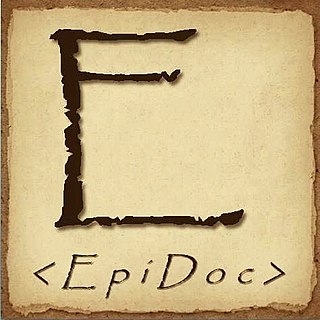
Papyrology is the study of manuscripts of ancient literature, correspondence, legal archives, etc., preserved on portable media from antiquity, the most common form of which is papyrus, the principal writing material in the ancient civilizations of Egypt, Greece, and Rome. Papyrology includes both the translation and interpretation of ancient documents in a variety of languages as well as the care and conservation of rare papyrus originals.

EpiDoc is an international community that produces guidelines and tools for encoding in TEI XML scholarly and educational editions of ancient documents, especially inscriptions and papyri.

The Digital Classicist is a community of those interested in the application of digital humanities to the field of classics and to ancient world studies more generally. The project claims the twin aims of bringing together scholars and students with an interest in computing and the ancient world, and disseminating advice and experience to the classics discipline at large. The Digital Classicist was founded in 2005 as a collaborative project based at King's College London and the University of Kentucky, with editors and advisors from the classics discipline at large.
Supplementum Epigraphicum Graecum (SEG) is an annual survey collecting the content of and studies on Greek inscriptions published in a single year. New inscriptions have full Greek text and critical apparatus, and studies of older inscriptions have brief summaries. The survey covers publications of inscriptions from the entire Greek world, although material later than the 8th-century A.D. is not included. Each issue contains the academic yield of a single year, delayed for a few years
The Inscriptiones Graecae (IG), Latin for Greek inscriptions, is an academic project originally begun by the Prussian Academy of Science, and today continued by its successor organisation, the Berlin-Brandenburg Academy of Sciences and Humanities. Its aim is to collect and publish all known ancient inscriptions from the mainland and islands of Greece.
The Greek-language inscriptions and epigraphy are a major source for understanding of the society, language and history of ancient Greece and other Greek-speaking or Greek-controlled areas. Greek inscriptions may occur on stone slabs, pottery ostraca, ornaments, and range from simple names to full texts.

The gens Accoleia, also spelled Acoleia, Acculeia, and Aculeia, was a minor plebeian family at Rome during the latter part of the Republic. Most of what is known of this gens comes from various coins and inscriptions.
The gens Occia was a minor plebeian family at Rome. Members of this gens are first mentioned under Tiberius, but must have been at Rome for much longer; for Tacitus speaks of Occia, a Vestal Virgin who died in AD 19, after serving faithfully for fifty-seven years. A few of the Occii pursued political careers in this period, but most are known only from inscriptions.
The gens Opsia was a minor plebeian family at ancient Rome. Members of this gens first appear in history during the reign of Tiberius. The most notable may have been Marcus Opsius Navius Fannianus, who filled a number of important posts, rising to the rank of praetor. Many other Opsii are known from inscriptions.
The gens Oscia was an obscure plebeian family at Rome. Members of this gens are first mentioned in imperial times, when a few of them appear among the Roman aristocracy. None of them are known to have held any magistracies, but an Oscia Modesta was the wife of a Roman consul during the time of Severus Alexander. A number of Oscii appear in inscriptions.
The gens Pontiliena was an obscure plebeian family at ancient Rome. No members of this gens appear in history, but a few are mentioned in inscriptions.
The gens Sabinia, occasionally written Sabineia, was a minor plebeian family at ancient Rome. Only a few members of this gens are mentioned in history, but others are known from inscriptions. Titus Sabinius Barbarus attained the consulship in the reign of Hadrian.
The gens Sabucia was a minor plebeian family at ancient Rome. Members of this gens are first mentioned in imperial times. The most illustrious of the family was Gaius Sabucius Major Caecilianus, who obtained the consulship in AD 186. Other Sabucii are known from inscriptions.
The gens Saenia was a plebeian family at ancient Rome. Members of this gens are first mentioned in the final century of the Republic, and Lucius Saenius attained the consulship in 30 BC.

Corseae or Korsiai was a port of ancient Boeotia on the Corinthian Gulf. It appears from Pliny the Elder that this town was distinct from Corseia, also in the western part of Boeotia, and that it was distinguished from the other by the name of Thebae Corsicae, that is the Corseae near or belonging to Thebes.
The gens Abudia was an obscure plebeian family at ancient Rome. This gens flourished during imperial times, and none of its members held any of the higher magistracies of the Roman state. Only Abudius Ruso, who had been aedile under Tiberius, is mentioned in history, but other Abudii are known from inscriptions.

The Corpus Inscriptionum Semiticarum is a collection of ancient inscriptions in Semitic languages produced since the end of 2nd millennium BC until the rise of Islam. It was published in Latin. In a note recovered after his death, Ernest Renan stated that: "Of all I have done, it is the Corpus I like the most."
The gens Vistilia or Vestilia was a minor plebeian family at ancient Rome. They occur in history during the early part of the first century, and became connected with the imperial family. Only one member of this gens is known to have held any of the higher offices of the Roman state: Sextus Vistilius, who attained the praetorship, was a contemporary and friend of Drusus the Elder.

Julius Euting was a German Orientalist.
The gens Tussidia or Tusidia was an obscure plebeian family at ancient Rome. No members of this gens are mentioned by Roman writers, but a number are known from inscriptions, including Lucius Tusidius Campester, who attained the consulship in AD 142.